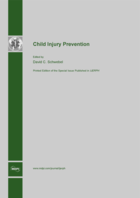Child Injury Prevention
A special issue of International Journal of Environmental Research and Public Health (ISSN 1660-4601).
Deadline for manuscript submissions: closed (15 January 2013) | Viewed by 173710
Special Issue Editor
Interests: child and adolescent injury prevention; temperamental and cognitive development; child clinical psychology; pediatric psychology
Special Issue Information
Dear Colleagues,
The 2008 release by the World Health Organization of the World Report on Child Injury Prevention brought children’s injuries to the forefront of international public health awareness; this awareness was re-affirmed with the 2012 release of the National Action Plan for Child Injury Prevention by the Centers for Disease Control and Prevention in the United States. Injuries are among the leading cause of death for children in every nation of the world. Each minute, at least one child globally suffers due to a serious “accident” that might have been prevented. This special issue has a broad focus on risk and prevention of child injury, with the ultimate goal to continue to build scientific knowledge on how we can reduce the public health burden of injury on children worldwide. Both empirical and review paper submissions are welcome, on any topic relevant to unintentional or intentional child and adolescent injury. Papers on injury prevention and intervention are especially encouraged.
Prof. Dr. David C. Schwebel
Guest Editor
Manuscript Submission Information
Manuscripts should be submitted online at www.mdpi.com by registering and logging in to this website. Once you are registered, click here to go to the submission form. Manuscripts can be submitted until the deadline. All submissions that pass pre-check are peer-reviewed. Accepted papers will be published continuously in the journal (as soon as accepted) and will be listed together on the special issue website. Research articles, review articles as well as short communications are invited. For planned papers, a title and short abstract (about 100 words) can be sent to the Editorial Office for announcement on this website.
Submitted manuscripts should not have been published previously, nor be under consideration for publication elsewhere (except conference proceedings papers). All manuscripts are thoroughly refereed through a single-blind peer-review process. A guide for authors and other relevant information for submission of manuscripts is available on the Instructions for Authors page. International Journal of Environmental Research and Public Health is an international peer-reviewed open access monthly journal published by MDPI.
Please visit the Instructions for Authors page before submitting a manuscript. The Article Processing Charge (APC) for publication in this open access journal is 2500 CHF (Swiss Francs). Submitted papers should be well formatted and use good English. Authors may use MDPI's English editing service prior to publication or during author revisions.
Keywords
- child injury
- drowning
- falls
- pedestrian injury
- motor vehicle safety
- burns
- poisonings
- head trauma
- neglect
- abuse






